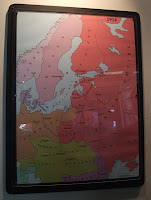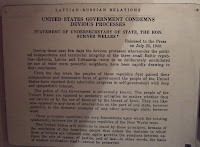Written 4th July
And the best thing about the Jurmala street part was that it meant we arrived on the outskirts of Riga, just on the otherside of the river from the Old Town really late on Saturday night and headed in on the Sunday morning when all the stag parties were quietly in bed or blearily nursing their hangovers over a coffee in TGI fridays rather than rampaging the streets.
Excellent.
Riga is more than a Latvian city. Founded in 1201 by a german bishop and his army of crusaders - sent by the pope to subjugate the indiginous tribes of Balts and Livs - it was the major german city in the Baltic region and an important trade centre between russia and the west. In the 17th century it was captured by the Swedes, and went on to become the largest stronghold of the Swedish empire (bigger than Stockholm) and then fell to the Russian Empire becoming Russia's third city after Moscow and St Petersburg in the late 19th century.
We headed first to the Museum of the Occupation of Latvia to continue our education.
Latvias recent history is similar to Lithuania's:
Self-declaration of independence from the Russian Empire in 1918, a prosperous inter-war period (Latvia apparently had one of the highest standards of living in the whole of europe), Soviet occupation and terror in 1939-41, Nazi 'liberation' and terror 1941-45, Soviet 'liberation' and terror 1945 onwards.
Although the general history is much the same, the Latvian museum had much more about the Nazi occupation than the Lithuanian museum. The Nazi's did come in proclaiming themselves to be the liberating force and promising a return to Latvian independence, self-government and latvian language. In reality though, the government was heavily controlled and the prescribed political language was german so change but not in a good way.
 The gemans set about opening up the mass graves of executed KGB prisoners and proclaiming the evilness of the Soviets - in pictures almost identical to those the Russians displayed to the world from Auschwitz - and, in a further twist, also continued their anti-semitic campaign by trying to paint all Jews as Bolshevik enemies with the plan of inciting latvian-instigated pograms against the jewish population, from which they could completely disassociate themselves, although apparently this was not successful.
The gemans set about opening up the mass graves of executed KGB prisoners and proclaiming the evilness of the Soviets - in pictures almost identical to those the Russians displayed to the world from Auschwitz - and, in a further twist, also continued their anti-semitic campaign by trying to paint all Jews as Bolshevik enemies with the plan of inciting latvian-instigated pograms against the jewish population, from which they could completely disassociate themselves, although apparently this was not successful.More information about the gulags - including a recreated wooden gulag dormitory building which was almost identical to the Birkenau huts, complete with wooden slatted bunks - and deportees and prisoners belongings including letters written on strips of peeled birch bark and sent home.
and other bits and pieces

The most fascinating things were the maps showing the borders and changes from 1914 to 1992,






the actual ballot papers in the 1940 elections, with only one candidate on (defaced by many people)
and copies of the actual pacts, treaties and agreements signed so you could read the actual words.
The Molotov-Ribbentrop Pact - which sealed the fate of the Baltics.

The Atlantic Charter - signed by Roosevelt, Churchill and later Stalin, which promised self-determination but which Stalin neglected to mention didn't apply to the single and indivisible USSR.
Apparently Churchill said in 1946 "this isn't the Europe we fought for" but by that time is was too late. And anyway, in all honesty, no one in europe was in any fit state for any further warefare at that time, which would have been inevitable and may have actually expanded Stalin's reach. Unfair as it was, it was probably the only possible outcome at the time.
Three things that really got me though.
1) the lofty words of the US Undersecretary of State in 1940 condemning the soviet intervention and 'devious and predatory activities' of the soviets in respect to the baltics (although re-read paragraph three in light of other countries in which the US has 'intervened...) and saying that whilst these activities continued, civilisation itself was underthreat

2) the very self-congratulatory letter from George Bush (senior) in 1991, congratulating Latvia on its independence and proudly stating that the US had never recognised the legitimacy of the soviet occupation and were pleased to have stood by independent latvia throughout the whole of the last 50 years - stood by and watched you mean. Having read all the stuff about the bravery of the resistance armies in Lithuania and Latvia, all the while in hope of suppirt from the West, even I found that insulting! As did the american we bumped into by that stand who was somewhat aptly celebrating his independence day in someone else's occupation museum. Like us he was feeling a bit guilty on behalf of his country and a new appreciation of just how easy we have it in the so-called 'free-world'.
And most unbelievable of all,
3) apparently we held some baltic states money (I forget how much but a fairly considerable amount, in the millions) in the bank of england, which, towards the end of the period of soviet dominance, we paid to the soviets to settle our debts!! How does that work???
Shocking stuff.
Out into the sunshine then and on with the 'one day in Riga' handy tour where we found:
The Blacheads House - an exact replica of the original 14th century frat house for unmarried german merchants which was destroyed by both the germans and soviets.

 St Peter's Lutheran church - the largest church in Latvia.
St Peter's Lutheran church - the largest church in Latvia. The 17th century house of a wealthy merchant named Mentzendorf
The 17th century house of a wealthy merchant named Mentzendorf The Reiterns Building - once one of the finest residences in the city.
The Reiterns Building - once one of the finest residences in the city. Past the old merchants warehouses
Past the old merchants warehouses Through the Central Market for some fine cherries and delicious squashed looking peaches and on to the Academy of Sciences, also known as Stalins Birthday Cake.
Through the Central Market for some fine cherries and delicious squashed looking peaches and on to the Academy of Sciences, also known as Stalins Birthday Cake. Through a gate in a fragment of the original mediaeval defensive walls with its seal of ancient Riga above it.
Through a gate in a fragment of the original mediaeval defensive walls with its seal of ancient Riga above it. Through café lined Liv Square to the 'Cat House' -
Through café lined Liv Square to the 'Cat House' - so-named for the cats which perch on the roof to demonstrate the feelings of the buildings owner towards the masters of the merchants guild to which he was refused membership
so-named for the cats which perch on the roof to demonstrate the feelings of the buildings owner towards the masters of the merchants guild to which he was refused membershipThe Large and Small Guilds
 for tradesmen and craftsmen respectively
for tradesmen and craftsmen respectively Past some tat shops - set of nesting communist leaders anyone?
Past some tat shops - set of nesting communist leaders anyone?
The Dome Cathedral
in the square
and Riga Castle (disappointingly unphotogenic and un-castle-like)
 The 'Three Brothers' - the oldest stone residence in Riga, dating back to 15th century, and its two neighbours.
The 'Three Brothers' - the oldest stone residence in Riga, dating back to 15th century, and its two neighbours.
 The Swedish gate - dating back to the Swedish occupation in 1698
The Swedish gate - dating back to the Swedish occupation in 1698Jacob's Barracks - the longest building in Riga and the only remaining set of barracks out of all those which once encircled the town.

 The 17th century Gunpowder tower
The 17th century Gunpowder towerand the painted crests of Latvia.
And finally the fabulous Art Nouveau - a flamboyant architecture style, heavily influenced at the start by japanese print art, and featuring mythical beasts, goddesses, plants and geometric shapes which swept through every major European city in the early 20th century but which is most prevalent in Riga - of Elizabetes Street, Alberta Street and elsewhere.







And back to the Old Town by way of the Orthodox church
and Riga's Freedom Monument.

Need a cheap beer after all that - I think this covers all the essentials...
And a nice-but-not-amazing meal of apparently Latvian specialties of meat pancakes with sour cream and hunters sausage with cowberry sauce and those obviously traditional american french fries.... Oh well, it was nice anyway
Home to the van where instead of a nice discrete tucking ourselves in with some telly, we found we had some new van-dwellers. Ants :( annoying but easily dealt with and far, far better than the flies or bitey things with which we are usually plagued.
And fortunately not a coordinated enough invasion to make us suspect an ant-y freeloader protest from local residents... sorry, I'll get my coat...
Night night :)






























Hey, we saw your bus next to Tallinna Lauluväljak and we couldnt resist to take some pictures, cause it´s the coolest thing we´ve seen on wheels:D Good luck with your travels:)
ReplyDeleteMerle, Kadi & Nele.
http://twitpic.com/238zbm
http://twitpic.com/23904w
Thank you! we think it is the coolest thing on wheels too :)
ReplyDelete